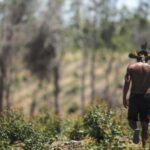You would be hard pressed to find a new forest investment strategy these days that doesn’t tout the benefits of climate and nature. Amidst rising shareholder demand and regulatory requirements for sustainable investments that benefit the environment, forest investment is a natural choice (no pun intended).
If you are an investor or investment manager, I would argue that creating a new strategy that addresses this demand fits into two broad categories:
- Sustainable investments – or ‘do no harm’ timberland strategies, and,
- Impact investments – or ‘make better’ forest investment strategies.
In a previous article, I discuss the difference between do-no-harm and make-better strategies and target setting. In this article, I’m going to dig into the make-better strategy and address a common concern that investors have when contemplating tagging their strategy as impact – that is:
Does impact creation compromise financial returns?
Read on to learn more about what I call the Impact-Profit Conflict Analysis. That is – a process for identifying where your financial and impact objectives might be at odds and what you can do to become aware of this early in the process and prepare to manage for such a conflict if it arises.

Sustainable Investments: Timberland investment plus ESG Data
Up above, I introduced the sustainable investment strategy for forest investment. Here, the conventional timberland investment model holds. The investment case is built upon traditional wood markets and optimizing forest management for timber production. To fulfil the minimum set of investor’s sustainability requirements, this strategy will collect ESG data. This will typically include the following metrics:
- Carbon accounting,
- Area managed under the principles of sustainable forest management,
- Area protected for conservation values.
In most cases, this will not require a change in business as usual, apart from the collection of the data. Carbon accounting is facilitated by standards such as the GHG Protocol that provide the methodology for turning forest inventory data and value chain emissions into a tonnes/year net sum CO2 emissions/removals. Collecting sustainable forest management area data can be as simple as recording the hectares under voluntary forest management certification (which is becoming status quo). Documenting protected areas can be as simple as recording the area under management not managed for commercial wood production (like riparian areas, steep slopes, and rocky sites). All in all, nothing changes with these strategies when compared to conventional timberland investment, but because ESG data is being collected, these strategies can still meet investors’ sustainability requirements if they fall into the ‘do no harm’ category.
Impact Investments: Forest investment for timber and ESG objectives
In this strategy, investors are looking for assets that combine traditional wood markets with rising markets for ecosystem services. They are looking for improvements in ESG (environmental, social and governance) factors – and here I must be explicit, that my definition of ESG-integration goes beyond risk management.
Both return drivers will be included in the financial model, and non-commercial ESG targets that are not necessarily linked to commercial returns may also be set. The metrics may be the same as in the sustainable investments I describe above, but what differs is the target setting. This strategy not only sets financial objectives, but also measurable ESG impact objectives. The adage of what gets measured gets managed applies here. Compared to the sustainable investment strategy, which may not manage for sustainability targets, apart from achieving forest management certification – this strategy is more active in managing for both timber and ESG objectives.
The Need for an Impact-Profit Conflict Analysis
In the sustainable investment strategy, an impact-commercial conflict analysis is not needed – as the north star on investment decisions is always timber maximization. Of course, there will be investment criteria and restrictions to safeguard ESG – such as avoiding assets that are not eligible for certification and not investing in regions of extreme fire risk, but in general an investment decision will always favor timber production.
But what about when there are also objectives for ESG benefits that inherently do not drive commercial returns in the traditional sense, or managing for these ESG benefits might mean a hit on financial returns?
Before writing off an impact approach from fear of negative impacts to the bottom line, I argue that your role as a responsible investor is to assess if this is true. Identifying the risks and opportunities between potentially conflicting commercial and impact objectives will allow you to make an informed decision and act accordingly.
The Building Blocks of an Impact-Profit Conflict Analysis
The Impact-Profit Conflict Analysis can simply be integrated into 4 steps of the strategy design phase, and then implemented in deal evaluation. It includes doing what you already consider in the investment process, but forces you to look through the lens of competing objectives through an integrated assessment, rather than the siloed approach. These are the steps:
- Theory of Change
- Investment Activities
- Material Risk and Opportunity Assessment
- Impact-Profit Conflict Analysis
Theory of Change
As I have written in a previous article, I firmly support the notion that the commercial and impact thesis of an investment strategy is developed as a team, bringing the ‘timber hats’ and the ‘sustainability hats’ out of their siloes and working together.
A great place to start is with the development of a Theory of Change (ToC) that integrates the impact and commercial objectives of the investment strategy. I have developed a free guide for ToC development you can access here. A ToC marks the pathway from the resources put into the strategy, through the investment activities that will be executed, the measurable outputs of the activity, giving rise to mid-term outcomes and the long-term aspirational impact objective. Developing a ToC with both commercial and impact objectives in mind can guide the management team to see the interconnectedness of objectives.
Investment Activities
Your strategy will define its investment activities, which may include investments into building a nursery, purchasing harvesting equipment, or investing in a sawmill to meet commercial objectives and running R&D tree species trials and engaging in wetland restoration on the impact side. As you design your investment activities, you will want to consider where capital allocation compromise might occur and which activities can complement objectives.
Material Risk and Opportunity Assessment
Work together through your Risk and Opportunity assessment to understand not only the materiality of individual risks and opportunities, but assess the material risks and opportunities that may occur because of the other objectives. Again, this is not a risk/opportunity assessment carried out independently by the financial controller and ESG manager. It is effective if everyone does it together.
Impact-Profit Conflict Analysis
This step is about finding solutions that support both financial and impact objectives. As a team, review the previous steps and brainstorm on ways that opportunities can be leveraged, and risks can be avoided or mitigated.
It is most effective if this exercise is carried out at the strategy level, and then in evaluating each deal – where the particulars will come into focus.
Impact-Profit Conflict Analysis Example for Deal Evaluation
To move out of the theoretical and into the practical, The following is a simplified Impact-Profit Conflict Analysis for a realistic investment strategy example. The investment strategy combines investing into reforestation activities that will 1. Grow species to targeting high-value tropical hardwood markets (profit) and 2. Restore native tree species to improve biodiversity in degraded ecosystems (impact). Below is a summary of the above named steps.
| Profit | Impact | |
| Objectives | High-value tropical hardwoods | Improve biodiversity |
| Activities | – Cultivating commercial tropical hardwood species in nurseries – Planting tropical hardwood species suited to the site – Silviculture regime that produces ideal timber qualities for the species’ end market | – Cultivating native species for restoration in nurseries – Planting native species on degraded sites suited to their ecological needs – Managing the restoration areas for species diversity (among trees, other flora and fauna) |
| KPIs | – Hectares planted – Plantation survival (% of planted) – Commercial inventory (m3) and (m3/ha) | – Hectares planted – Restoration survival (% of planted) – Presence of previously identified target species to recover (#number of key species) |
| Risks | – Biodiversity improvement strategy is a drag on the IRR – Not maximizing nursery space for commercial tree propagation – Not maximizing productive area for commercial reforestation – No market premium for biodiversity-enhancement strategies – Costs of biodiversity management | – Profitable wood market strategy takes precedence over biodiversity objectives – Insufficient nursery capacity for native species – Invasion by exotic species – Only poor sites left for native regeneration – Management focused on high-return generating activities, and impact strategy falls away |
| Opportunities | – Planting highly productive degraded areas with high-value commercial hardwoods – Access niche, high-price wood markets, where buyers pay more for the biodiversity improvement elements – Reduction of impacts from climate risk with mixed species management | – Develop a business opportunity for propagating native species seedlings for sale – Planting degraded areas not suited to commercial production, but with high biodiversity improvement potential with native species – Participation in emerging biodiversity markets |
| Impact-Profit Conflict Analysis: Solutions | – Top-down executive leadership communicates the joint objectives to the organization – Have the management area that is to be reforested for commercial and native species assessed jointly by a forester and biologist/ecologist specializing in the commercial and impact objectives. Jointly they prepare a plan that optimizes the area for commercial and impact objectives, understanding the concerns posed by the other – Develop nursery capacity that supports both commercial and native restoration objectives and explore the opportunity to procure tree material from other businesses in times of need – Begin early to market wood products to niche buyers who will pay a premium for this forest management approach – Dedicate resources to advance the biodiversity market case – Monitor KPIs and financial performance to understand if objectives are being balanced and commercial returns are not being negatively impacted. Course-correct as needed – Monitor acute and chronic climate events and their impact on the forest vs the alternative (pure plantation model and pure protection model) |
At the end of the day, the key determinant of success in a forest investment strategy that combines both commercial and impact objectives (that at times may be at odds) – is collaboration within your team. It requires the adoption by top management that this strategy has multiple objectives, and a trickle-down effect is likely to occur in your organization. In some cases, it will require a shift in mindset of the people in your team away from originally held siloed opinions, where the timber-tunnel visioned forester, and the environmental activist need to come around to hear the other side’s point of view.
Need Support with your Profit-Impact Integrated Forest Investment Strategy
If you are in the process of revamping your forest investment strategy to integrate impact objectives, and you need some support in breaking out of siloes – I have some ideas. Reach out to learn about the workshops I lead to help your team to carry out a profit-impact conflict analysis, and develop a plan that builds on opportunities and reduces risk for a forest investment strategy targeting financial returns and impacts. I’m always happy to work with Investors looking to extract the most impact and value from their forest investments.
Did you like this article? Sign up now for the ForestLink’s newsletter, where you’ll receive technical advice, reflections, and best-practice guidance to support you with your forest-linked investment strategy or business straight to your inbox.





